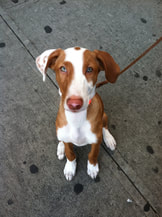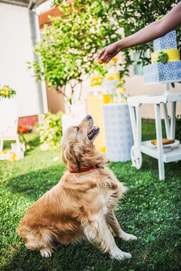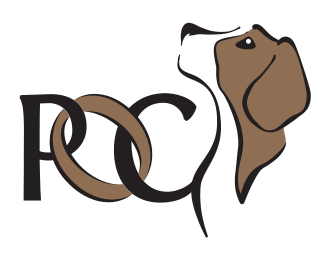|
I love going hiking with my dogs, but there are some things that make that experience more enjoyable for us both. Teaching Loose Leash WalkingI find hiking so much more enjoyable when my dogs aren't pulling me down the trail! Although it can be frustrating when you just want to go on a hike, I highly recommend taking the time to train your dog to walk nicely on a loose leash. These two things aren't mutually exclusive, I taught Tristan how to casually walk on a loose leash on trails, however, I had to go out knowing that I'd be stopping and turning if he pulled so I wouldn't cover as much ground, or if I stuck with a predetermined route, it would take us longer to complete it. Consistency is the key here - if your dog gets to explore by dragging you along behind them, that's what they'll do in the future.
Here is how I taught Tristan not to drag me down the trail: I usually work with people when they are wanting their dog to learn how to do something, either a specific skill or a different behavioural response. To teach our dogs what to do, we commonly use food or treats. Once our dogs understand the skill, and can perform it in a variety of environments around different distractions, we can start to reduce the use of treats. Here are some things to consider.
Can your dog perform the desired skill consistently, to the level you want? If not, your dog hasn't fully learned the new skill, and their performance is unlikely to improve if you stop rewarding their efforts. First, we need to get the behaviour reliably. Can your dog perform the desired skill consistently, in the face of distractions? Ideally we teach the skill in a low distraction setting, and then once the dog can respond consistently, introduce distractions strategically so that the dog can succeed in the face of the distraction, growing their confidence and ability to respond even when other things are going on. Some distractions to consider:
Now that winter is here, training outside gets more complicated if you want to reward your dog. Stick the mitts in the treats? Pull the glove off, deliver the treat then stick your hand back in? If neither option appeals to you, consider using a lickable treat instead!  Squeeze tubes are great for this. Simply find whatever soft food you'd like to use (i.e. canned dog food, plain pumpkin, peanut butter, liver pate, etc.), get it to the right consistency (not too chunky, not too runny - this may require mixing it with something else), put it into the tube and dispense as needed! Great for using in the winter, as all you need to do is remove the lid and squeeze a bit for your dog to lick, so they are mitten friendly.  You know the kind, the dog that stares at you after you give a particular cue, waiting to see evidence that you have a treat that they will get. If that evidence is shown, they respond to the cue. Otherwise, they high tail it off to investigate better options. A frustrating loop to find yourself in! Likely the dog has learned that if there is no sign of an immediately available reward, that there will be no reward forthcoming. I'm certain that you didn't intend to teach this - but it happens fairly frequently without us being aware of it. The good news is - it is fixable. So you have a verbal cue that you want your dog to respond to without any additional signals – what do you do? Ditch the Lure Make sure your puppy/dog can respond to the verbal cue and signal without you holding any food in your hand. It’s hard to fade a signal if your dog is following a lure! Teaching your dog that responding correctly can cause you to produce a reward is an important lesson and can be helped by using a marker cue such as “yes” when your dog performs the action you will reward. Talk First, Move afterMake sure you are giving your verbal cue (ie. “down” for lie down) PRIOR to moving your hand. Then give your down signal. What we are doing is setting up a chain “down” = hand signal = down action will be rewarded. Since our dogs are so tuned into our movements, if we give the verbal cue “down” at the same time as we move our hand to give the signal, the vast majority of the time the dog will perceive the signal and respond correctly without paying much attention to the word. In effect, presenting both cues at the same time allows the signal to overshadow the verbal cue. By presenting the verbal cue followed by the signal, we take advantage of our dogs tendency to anticipate once they realize that the word predicts the signal. This is a difficult step for us as a very verbal species!
|
Categories
All
Archives
May 2024
|
Online Learning Class Schedule Puppy Classes Manners Classes Sport Classes Scent Classes Agility Classes Private Lessons
Copyright 2020 Positively Obedient Canines
